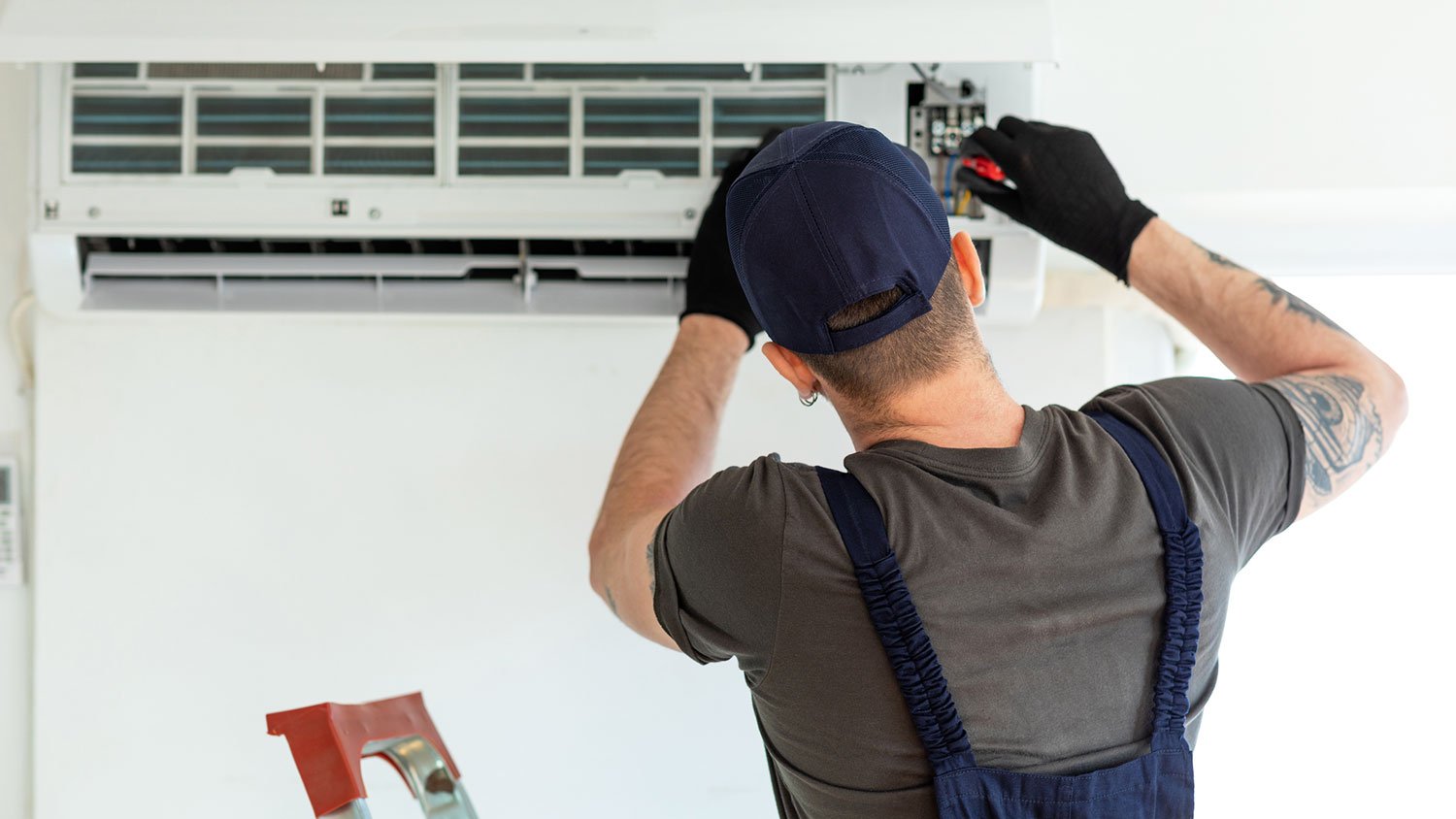4 Different Ways to Clear a Clogged AC Drain Line (and How to Prevent One in the Future)
Clear the way for cool goodness


An AC drain line removes condensation from the cooling system, but clogs can occur due to dirt and debris or algae and mold growth.
Signs of a clogged AC drain include pooling water, a musty smell, visible mold and algae, and poor cooling.
You can use liquids like vinegar or water, a wet/dry vacuum, an air compressor, or a snake to clear clogs in your AC drain.
When your air conditioning system is running smoothly, it's easy to overlook the importance of its drain line. However, a clogged AC drain line can quickly become a major headache, leading to water damage, reduced cooling efficiency, and even mold growth. Let’s explore why this common HVAC problem occurs, how to recognize the signs of a clog, and the best methods for unclogging and preventing future blockages.
What Does an AC Drain Line Do?
Your air conditioning system produces condensation as it cools warm air. This moisture needs to be removed from the system to prevent humidity buildup and potential damage. That's where the AC drain line comes in. It's responsible for channeling excess water away from the unit and safely draining it outside your home.
Why Does It Get Clogged?
Despite its vital role, the AC drain line is susceptible to clogs. Several factors in your cooling system can contribute to blockages. The most common reason for a clog is the presence of foreign objects. Dust, dirt, and other debris can enter the drain line, especially if the system's air filter is dirty or clogged. This debris can accumulate and obstruct the flow of water.
Algae and mold growth can also cause a clogged AC drain line. The dark, damp environment inside the drain line is the perfect breeding ground for these organisms, and over time, they can accumulate and form blockages. Additionally, if the AC drain line is not installed correctly or lacks proper slope, water may not flow efficiently, increasing the risk of clogs.
Signs You Have a Clogged AC Drain Line
Identifying a clogged drain line early can prevent potential damage and stop you from needing to pay for expensive HVAC repairs. Look out for these warning signs:
Pooling water: If you notice water leaking around your AC unit or water stains on the walls or ceiling nearby, it could indicate a clog in the drain line.
Musty odors: A clogged drain line creates a stagnant environment perfect for mold and mildew growth, leading to unpleasant odors emanating from the AC vents.
Reduced cooling performance: A blockage can affect the efficiency of your AC system, resulting in decreased cooling capacity and higher energy bills.
Visible mold or algae: If you inspect the drain line and notice visible mold or algae growth, it's a clear sign of a clog that needs attention.
How to Unclog Your AC Drain Line
If you're confident in tackling the clog yourself, you’ll have to start at the access point to your AC drain line. You can find it near the indoor air handler unit or the exterior condenser unit. Note that it’s important to shut off power prior to doing any work on your HVAC system to ensure safety, and you can restore power once your work is complete.
Flush Out the Blockage
To clear a clog caused by organic matter, you can flush the drain line with clean water, a mixture of vinegar and water, or even bleach. The flushing method is particularly effective at dissolving buildup from mold and algae. Vinegar is safer for the environment and less corrosive, while bleach is more potent but requires careful handling to avoid damage to surrounding surfaces and components.
Use a Wet/Dry Vacuum
Using a wet/dry vacuum is an effective method to unclog an AC drain line. By creating suction, the vacuum can dislodge and remove debris, restoring proper drainage. It's a simple and efficient DIY solution, especially for stubborn clogs that may not respond to other methods. If the clog persists, you may need to hire an HVAC professional to help.
Use an Air Compressor
Blowing air into the drain line with an air compressor is another effective approach to get rid of tougher clogs. A burst of pressurized air can dislodge debris that’s obstructing the line, restoring proper drainage. Use caution if you decide to try this method because you could damage the line if you’re not careful.
Use a Plumbing Snake
Using a plumbing snake is a viable method to remove the toughest clogs that the previous methods couldn’t clear. By inserting the snake into the line and maneuvering it carefully, you can dislodge and remove stubborn blockages, restoring proper drainage and airflow in your HVAC system.
DIY vs. Hiring a Pro for a Clogged AC Drain Line
While DIY solutions can sometimes resolve minor clogs, more severe blockages may require the expertise of a local AC repair company. For example, simple DIY methods like flushing the drain line with vinegar or using a wet/dry vacuum can often clear minor clogs. However, if you're not comfortable working with HVAC systems or the clog persists, it's best to seek professional assistance.
HVAC technicians have the tools, knowledge, and experience to diagnose and address clogged AC drain lines safely and effectively. They can also inspect the entire system for any issues that may contribute to clogs.
Risks of Not Addressing a Clogged AC Drain Line

Ignoring a clogged AC drain line can have serious consequences like water damage, mold and mildew growth, and reduced HVAC efficiency. Excess water from a clogged drain line can leak into your home and cause water damage to walls, ceilings, and flooring.
Standing water and high humidity resulting from a clog also provide the perfect environment for mold and mildew growth, meaning your health is at risk. Plus, you’ll have to pay for costly mold remediation. And, of course, your energy bill may rise due to a clogged drain line since it can impair the efficiency of your system.
Clog Prevention Tips
If your AC drain line keeps clogging, follow these preventive measures to stop future blockages:
Regular maintenance: Schedule annual maintenance for your HVAC system, which includes cleaning and inspecting the drain line.
Change filters: Replace AC filters regularly to prevent dust and debris from entering the system and creating clogs.
Keep the surrounding area clean: Keep the area around your AC unit clean and free of debris to minimize the risk of clogs.
Install a drain line cleaner: Consider installing a drain line cleaner or algaecide treatment to prevent algae and mold growth.





- Furnace Repair
- Air Conditioning Repair
- HVAC Repairs
- Furnace Installation
- Wood & Pellet Stove Repair
- Dehumidifier & Humidifier Repair
- Heat Pump Companies
- Swamp Cooler Repair
- Wood Stove Services
- HVAC Companies
- Commercial A/C Repair
- Geothermal Installation
- Air Conditioning Installation
- Boiler Repair
- 24 Hour Furnace Repair
- Geothermal Repair
- Heat Pump Repair
- Humidifier Installation
- Thermostat Repair
- Thermostat Installation
- Nest Installation
- Heating & Cooling
- Heating Repair
- Furnace Cleaning
- Furnace Tune-Up
- HVAC Technicians
- Subcontractors
- Furnace Maintenance
- Plumbing & Heating Companies
- Wood Stove Inspection
- Mini Split Installation
- Wall Heater Repair
- Duct Installers
- How to Clean AC Drain Lines and Prevent Future Clogs
- Why Is My AC Leaking Water? 5 Common Causes and How to Fix It
- How to Fix an AC Leak: A Step-by-Step Guide
- How to Stop Condensation on AC Unit: 6 Tips to Try
- 8 Ways to Unclog a Sink or Tub Drain
- How to Clear a Main Sewer Line Clog Yourself in 7 Ways
- How to Unclog a Washer Drain: 5 Potential Methods
- 5 Easy Ways to Remove Hair From Your Drain
- Know Who to Call for a Clogged Drain
- How to Unclog a Shower Drain With Standing Water










